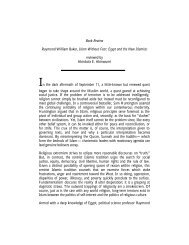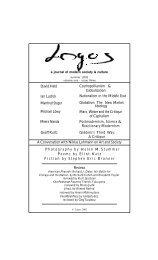Michael J. Thompson Stephen Eric Bronner Wadood Hamad - Logos
Michael J. Thompson Stephen Eric Bronner Wadood Hamad - Logos
Michael J. Thompson Stephen Eric Bronner Wadood Hamad - Logos
Create successful ePaper yourself
Turn your PDF publications into a flip-book with our unique Google optimized e-Paper software.
Abbas Amanat<br />
Such greater solidarity and group identity however did not result in<br />
reconsideration of the Shi’ite legal thought or any serious attempt to<br />
institutionalize the informal marja’iya leadership. Study of fiqh in the<br />
seminaries of Najaf, Qum and elsewhere remained almost entirely loyal to the<br />
arcane precepts and practices of the Shi’ite law and its obsessive<br />
preoccupation with devotional acts (’ibadat) and contracts (’uqud). The<br />
striking persistence of legal archaism among the Shi’ite jurists can be<br />
explained in part by inherent conservatism of the legal curriculum and in part<br />
by isolation from the society’s new secular discourse. Left out of the new<br />
state-run judiciary, the Shi’ite teaching circles in Najaf and Qum made<br />
almost no attempt to address new issues of public law or even offer a modern<br />
reading of the old legal texts. The so-called hawzas continued to operate<br />
along the informal teacher-pupil patronage and produce growing number of<br />
jurists and/or preachers in need of new congregations.<br />
A number of marja’s that “emerged” after the death of Burujirdi in 1960,<br />
including Ayatollah Khomeini, were no doubt more organized in their<br />
teaching and charitable operations. Yet there was no attempt in the clerical<br />
circles to revisit the nature and conditions of marja’iya, let alone arrive at a<br />
consensus about criteria for such leadership or the hierarchy. As much as the<br />
lay constituency of the marja’as grew and the funding sources improved, no<br />
equivalent of an ecclesiastical hierarchy emerged even though there existed a<br />
fairly coherent network of the ’ulama throughout Iran, southern Iraq and<br />
Lebanon.<br />
The defuse marja’iya leadership of this period relied heavily on both the lay<br />
and the clerical “followers.” To mark their place in a complex game of<br />
prestige and popularity the marja’s depended on their followers for higher<br />
standing. Naturally, at times they were bound by their whims and wishes. As<br />
Mutraza Mutahhari, a prominent follower of Khomeini and a leader of the<br />
future Islamic revolution pointed out in the early 1960’s, in this popularity<br />
contest no marja` could survive without his constituency's financial and<br />
moral backing. In a conference organized by some religious modernists on<br />
the theme of marja’iyat, the largely modernists, among them Mahdi<br />
Bazargan, joined together with a new generation of activist clerics, such as<br />
Mutahhri, to urge the marja’s to bring some order into the notoriously<br />
chaotic world of Shi’i clerical leadership.<br />
<strong>Logos</strong> 2.3 – Summer 2003




